[Updates: Dec 23, 2021; Jan 31, 2022 ; Feb 16, 2022 ; March 17; 2022; April 28, 2022]
This page is for general information on tools to help us fight COVID. I'll focus primarily on respirators and air quality here and less on vaccines:
- Masks and Respirators section
- Air Quality Measurement (CO2, etc.) section
- HEPA Filtering section
- 2m distancing
- Airborne vs. Droplet vs. Surface transmission modes [April, 2022]
Here's the summary: N95s disposable respirators are more comfortable and more effective at blocking COVID than surgical and cloth masks; air quality measurement is easy and should be done to verify that the air that you're breathing is safe, COVID or not; and HEPA air purifier units are a good addition to classrooms, lunch rooms and restaurants, offices and homes.
Masks and Respirators

It's time for N95 or better masks. The evidence (references March 2022) is overwhelming that cloth and blue surgical / procedure masks are insufficient, as shown in study after study, and are summarized in graphics 1, 2 and 3 showing masking combinations versus "time to infection" (via Asit Mishra, Lisa Broseau and ACGIH; Alex Huffman's thread). We don't need to get hung up on absolute times... it's more important to focus on relative reductions in durations based on mask types.
Ditch your ill-fitting cloth mask. Throw out the blue surgical / procedure masks. It's 2022. Get an N95 or better. N95s are inexpensive, plentiful and are better. The BC CDC says ditch your surgical mask and use something better (via @PPEtoheros). Here's an explanation about why some people wrongly use surgical (procedure) masks instead of better N95s (another thread).
What is an N95? Start with looking at differences between masks in this graphic. For post-secondary instructors and public school teachers, you should consider wearing the best quality N95 or better respirator you can. At minimum, you should be wearing a disposable N95-style model, like the CA-N95 or CA-N99 from CanadaStrong. I've bought and tested several models, both for kids and adults and can say that they are practical and usable.
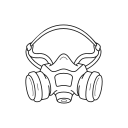
There is a real problem with "blue surgical masks only" policies in places like schools or hospitals. Between now and the time that they adopt N95 masks you can consider
- Wearing a blue N95-class mask (e.g. Amanda Hu) from CanadaStrong.
- "bracing" your blue mask (e.g. this thread) using a product like FixTheMask.
- doubling-up on your mask by wearing an N95 underneath a blue surgical mask.
A good alternative to disposables masks are re-usable "elastomeric" respirators. I find that they fit better than the CA-N95s, solving the "foggy glasses" problem. However, because they look like gas masks, they attract attention and I understand why some people would be embarrassed to wear them. They also require maintenance, so if you're not going to take care of them, you may wish to stick to the disposables. I've bought and testesd both GVS and Dentec models and can say with confidence that both vendors are good.
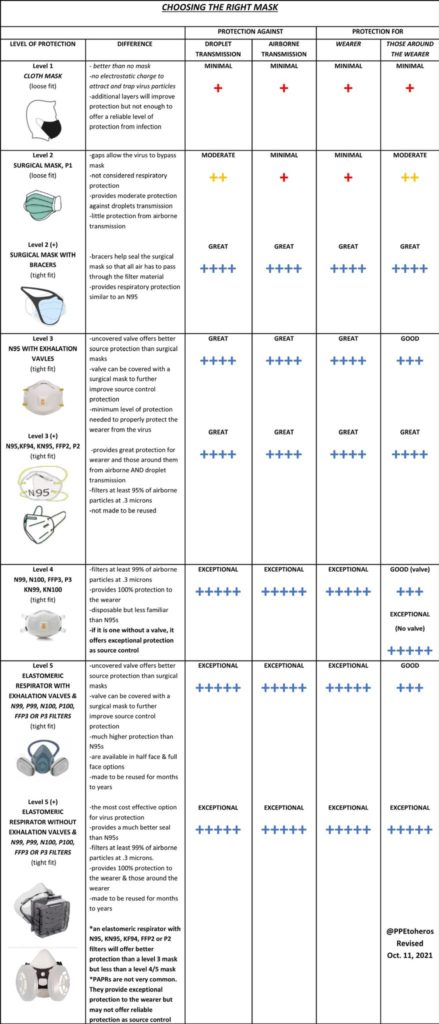
- Disposable N95 or better (overview graphic)
- Verified vendors
- good vendor list (Canadian)
- good vendor in the USA. (Project N95)
- CanadaStrong CA-N95, 508 or 510
- There are versions for kids and adults. My family has been using both the adult and kitversions for half of 2021.
- CanadaStrong CAN99
- There are versions for kids and adults. We've been using the adult ones. My wife really likes her CAN99.
- CAPPEM's List of Canadian Manufacturers lists
- for Canadian Disposable masks/respirators
- for Canadian Reusable respirators
- Clean Air Crew's list of elastomeric respirators (Elipse, Dentec, 3M, one for kids, etc.)
- KN95? I wouldn't recommend KN95 or KF95 anymore. While you can also get KN95 or KF95 masks (two Asian standard for N95-style respirators), it's hard to justify them anymore given that we have many good local (Canadian) manufacturers with reputable local vendors.
- Counterfeits? There are lots of fake masks out there. Try to buy directly from a reputable source like CanadaStrong or United Canada. Avoid Amazon whenever possible. Check out this source if you're in the US.
- Sizing & Choosing your mask.
- If you can, buy a few models and try them out for comfort and fit. This video gives a brief overview of how to put on an N95-style (KN95). Pay particular attention to pinching the nose piece and the inhale/exhale part.
- Kids:Children should wear kid-rated masks like the CA-N95 KIDS or CAN99e
- Adults: Dent-X N95s via CanadaStrong, for adults, from smallest to largest: '510, '508 and CA-N95. I have an "average" sized" adult caucasian male face and I find the 510 model fits my face well, but find the blue CA-N95 is a little too large.
- The 3M Aura (9205 and 1870 model) is a "gold standard" NIOSH N95 mask and it's available from United Canada. My parents use them, however I have not and don't have a good recommendation for sizing.
- From @PPEtoHeros via @DrEricDing : "Choosing the Right Mask"
- Verified vendors
- Re-usable elastomeric respirators ("gas-masks")
- These look weird, but they often work better than the disposables.
- If you wear glasses and you want to eliminate the "fogging" issues with disposable masks, then consider these. There are complications:
- Glasses sit funny on these because they are thick and sit higher.
- You should clean them on a regular basis with soap and water.
- Facial hair can be problematic. I have a goatee and keep it cropped to fit withing the mask.
- I get "fish pucker" mouth with the GVS model because it is designed to be low profile. Makes it a challenge to speak with. Not impossible or painful, but a little uncomfortable.
- GVS low-profile, "source control" respirator
- GVS SPR-644 for larger faces. (amazon link)
- Adult men should default to these. My wife tried it and found the chin area had a big gap.
- GVS SPR-643 for smaller faces. (amazon link)
- Adult women should consider these, as should younger men.
- Do not get the GVS-4xx series sold at places like Lee Valley.
- The exhalation valve on those is open and will spread COVID if you are infected. Those models are meant for industrial settings like woodworking or metal shops.
- GVS SPR-644 for larger faces. (amazon link)
- The Dentec ComfortAir
- More bulky than the GVS model but easier to speak in. Comes in black or white, N95 or P100. The N95 has a better aesthetic, but the P100 has better protection.
- Fogging glasses?
- Noticed "fogging" issues with the disposables? It could be that the seal is still good but that convection through the material is causing fogging. That means that the mask could still be sealed even with fogging and that you're still safe.
- I've noticed that fogging with disposables makes it harder for me to work, so I've switched to elastomerics like the GVS 644 and Dentec ComfortAir. I have found that the Dentec is easier to use with glasses on.
- How long can you wear a mask for?
- Disposable N95s:
- The FN-N95-508 by Dent-X from CanadaStrong are rated for "8 hours of accumulated use (e.g. eight 1-hour trips... or one 8-hour day)"
- It may be possible to wear them longer. If you have the choice, swap out at least once a day with your disposable. However, even a lightly used mask is better than nothing.
- Elastomeric respirators:
- GVS SPR-644 are rated for a minimum of 1 month of use (per paper P100 filter manual)
- The Dentec ComfortAir is rated for...
- In general, it appears that elastomerics can be used much longer: "respirator masks with particulate filters can be used for an extremely long duration in a hospital setting, at least 1 year, so long as the filter is not damaged or soiled [15]"
- Disposable N95s:
- On fit testing...
- Video overview of official fit-testing.
- Ignore people who say that "improperly fitted N95s are useless". They're wrong. The snobbery over "professional fit testing" on N95s is inappropriate. An N95 that is not professionally "fitted" is still better than a surgical mask. (Brosseau, 2010). There's actual science to back up this claim. Again, an N95 is better than a cloth or surgical mask via CBC. One can learn to self-fit the mask over time.
- Evidence on professional fit testing not being critical:
- Ontario document & excerpt. highlight. (c/o Dr. Vivian Stamatopoulos)
- Graphics (1 and 2 and 3) showing masking combinations and "time to infection": via Asit Mishra and Lisa Broseau and ACGIH.
- User seal-checking of the mask (thread)
- Video from 3M: https://www.youtube.com/watch?v=DzIDhYGnDIM&feature=youtu.be
- CDC PDF: https://www.cdc.gov/niosh/docs/2018-130/pdfs/2018-130.pdf
- Dentec demonstration video of a seal-check.
- Kimberly-Clarke donning, doffing and seal-check of a disposable respirator.
- Self-fit-testing is do-able:
- Start at 1:35 here: https://www.youtube.com/watch?v=1-bZJjgLZYg
- DIY fit-testing setup by Kelly et al in Disaster Medicine and Public Health Preparedness journal (c/o @Bertrandization)
- The US Army Public Health Centre has guidance on DIY fit testing. (c/o Jennifer McDonald; thread)
- "Mask Fit Matters" from the COVID Action Group (Winter/Spring 2022) [update Feb 16, 2022]
- Fit testing with Sweet n' Low (twitter thread; YouTube video) [update Feb 17, 2022]
- Suppliers:
- Staples Professional for Dentec respirator filters and goggles.
- Amazon.ca for P100 filters for GVS respirators.
- At York, here we have a system to provide elastomeric respirators to employees.
Air Quality measurements (CO2 and PM2.5)
It's important to monitor the quality of the air in the spaces your work, play, transit and live in. While you could measure things like "particulate matter" (PM2.5) or VOC (volatile organic compounds), you'll get the most "bang for your buck" by measuring carbon dioxide (CO2) in the places you work, play, transit or live in.

Warning: no matter what the air quality sensor is telling you, it's important to default to wearing a respirator (N95 or better) when indoors. The ventilation system may not be uniform in the area you find yourself in and so COVID may linger in some areas. Be cautious and wear your respirator.
Carbon Dioxide (CO2) levels measures the amount of air being shared with other people. Roughly speaking, here are values you should watch out for:
- Outdoors, your CO2 sensor should measure around 400 to 600 PPM.
- Good indoor air that is being refreshed properly should remain between 600 and 800 ppm.
- Marginal indoor ratings are 800 to 1200 ppm. Try opening one or more windows or minimizing your time in that space.
- Anything above 1000 ppm consider opening a window and talking to the building manager to improve ventilation or to install a HEPA air purifier in the room.
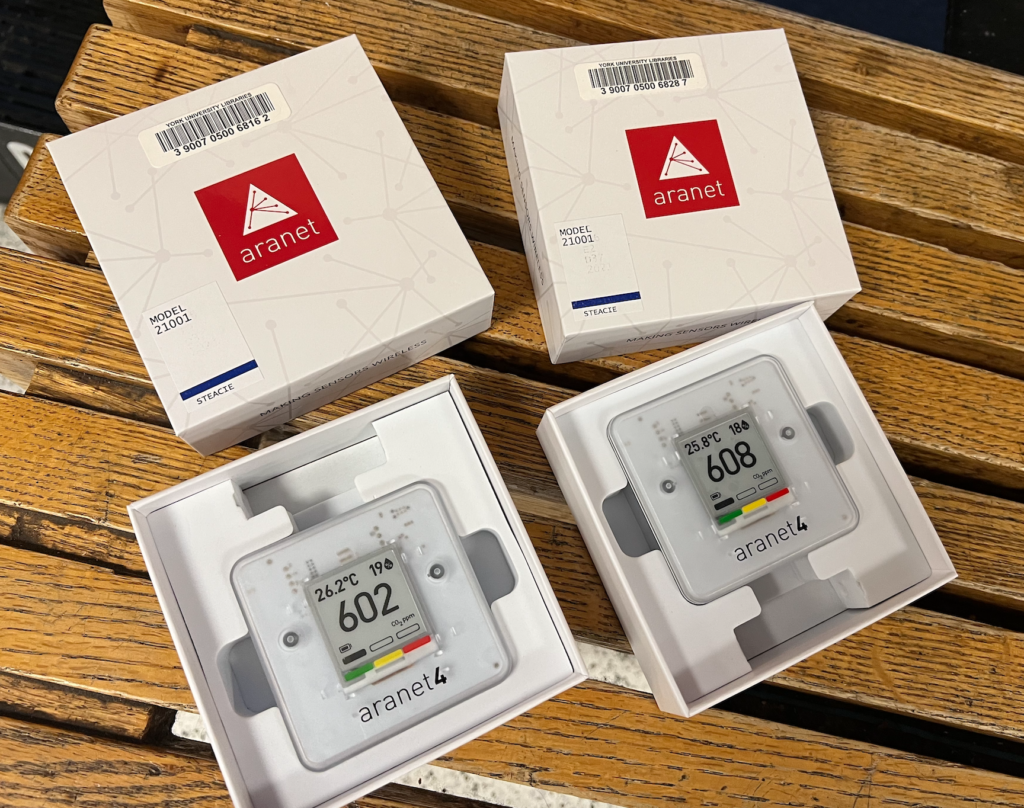
HEPA air purifiers work to filter out particles from the air. They'll capture particles that carry COVID. While a CO2 sensor won't tell you if a HEPA filter is working properly (because HEPA doesn't scrub CO2) if the CO2 levels are high and there is no HEPA unit in the room, then you should absolutely feel comfortable telling your supervisor or building manager: "the air quality is not good here because CO2 levels are consistently above 1000 ppm [for example]. It's possible that the mechanical ventilation system isn't exchanging the room's air suffiently. We should augment the existing ventilation system with an in-room HEPA." You can also ask that a professional air quality audit be conducted and that they make sure to get the "air changes per hour" (ACH) to at least 6 ACH or better.
At York University you can borrow one of two Aranet4 CO2 sensors from the Steacie Library. They're easy to use, either by reading the display directly or by connecting them to your phone over bluetooth.
I recommend getting an air quality sensor to help you know if the air you're breathing is good. Start with a CO2 sensor. Don't buy anything under $150 as the electronics inside need something called an NDIR device and it's not cheap. Here are recommended devices:
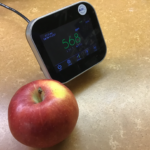
- Aranet4
- Portable, long lasting battery. Easy to use. Default to this.
- YorkU community members can sign one out from Library.
- I've used it. I like it.
AirQ(no longer available)Desktop use.Easy to use. No bluetooth. Good for offices, labs, home.I've used it. I like it.
- IQAir
- Combines both PM2.5 and CO2.
- It looks good. I haven't tried it.
- TempTop
- Combines CO2 and PM2.5.
- Ensure that it's the one with the "NDIR" sensor in it.
- Traditional instrument.
- I've seen others use it.
- co2.click
- Inexpensive ($200 CDN)
- Ships out of Montreal
- I haven't tried it, but it's NDIR-based.
Here are tips and links on CO2 sensors:
- Dustin's tips about CO2 sensing (uncertainties)
- General usage of CO2 sensors:
- Schools, CO2, Mech Ventilation, HEPA poster.
- General usage video: https://youtu.be/q45TIsyOuvs (Aranet4)
- General usage review: https://youtu.be/b88e9I_HwQg (Aranet4)
How do you calculate or properly measure air quality? [to be updated]
Thread by Joey Fox (April 2022)

Air Purifiers (e.g. HEPA)
If you can afford it, get an air purifier and use it. When in doubt, default to a known manufacturer like Honeywell (@ HomeDepot) or Austin Air or Copernicus. You can also refer to Consumer Reports.
Air purifiers like the ones by Austin Air and Copernicus are currently being used in Toronto school boards like the TDSB and CS Viamonde. I use a Honeywell HEPA that I bought at Home Depot in my home. They are safe and can be used in buildings with existing mechanical ventilation.
- "When a health authority expresses concern" show them this.
- Infographic on airflow patterns.
- Masks4Canada "Room Ventilation and Filtration Guide"
- CDC's air quality calculator (for homes)
- David Elfstrom's thread on sizing HEPA filters for classrooms (400 CFM) and eating areas (800 CFM). (ThreadReader)
- Joey Fox's tips on choosing an air cleaner.
- Clean Air Stars (@cleanairstars) has a list.
- Clean Air Crew(@CleanAirCrewOrg) has a Portable Air Cleaner Buying Guide c/o of Dr. Marwa Zaatari (@marwa_zaatari)
- Discussion about why ventilation and filtration are good.
- Boeing says that cabin HEPA isn't enough. (Lazarus Long's Twitter source)
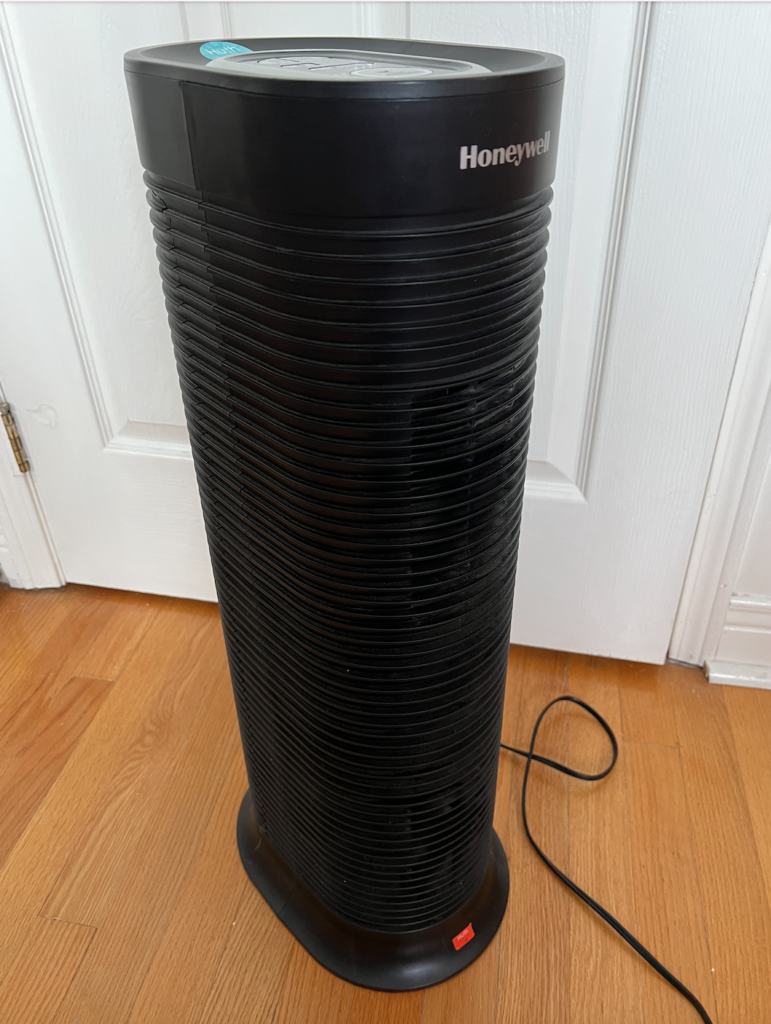
Here is a comprehensive 25 minute video on clean air in the classroom from Bill Hayward of Hayward Score.
I can't stress this enough: if you have any doubts about the HEPA unit that you are about to buy then get one from a reputable source like Honeywell, Austin Air or Copernicus. If you bring in a non-brand unit into the workplace you may get push-back or may get in trouble with your supervisor. Even at places like York University there are silly bans on such devices. The bans have been implemented in typical "cover your ass" style based on a mistrust of workers and they do nothing to actually improve the legal requirement to provide a safe workplace. So don't give your employer extra reason to stop you from using an air purifier by bringing in a non-certified or difficult to assess model. Not "HEPA-equivalent" or "Better than HEPA" or "with new XYZ technology that goes above HEPA". Only bring in a known good HEPA device like Honeywell, Austin Air or Copernicus.
And, if your supervisor gives you grief about the "HEPA units move air around and that could spread COVID" then tell your supervisor to remove the air dryers in the washrooms, replace all computers with fans in the office with fanless tablets and have the custodial staff swap out their vacuum cleaners for brooms and dustpans.
If you're feeling confident that your employer or school board will listen, consider Corsi-Rosenthal boxes as an alternative or complement to commercial air purifiers. A number of faculty at York University will be following the example set at many universities in the US by bringing CR Boxes in Winter 2022.
Corsi-Rosenthal Boxes (DIY Air purifier) links:
- CRBoxes meet ASHRAE recommendations. c/o @WBahnfleth. They are "aligned with ASHRAE pandemic guidelines" (@DavidElfstrom)
- 3M is now making videos about CR Boxes. (April, 2022)
- CR Boxes help with mixing (Dr. Prather)
- Introduction to Corsi-Rosenthal boxes by Dr. Corsi (YouTube video ; March 16, 2022)
- CR Box using PC fans : https://twitter.com/Mw_ottawa/status/1511417707383734274 (April 5, 2022)
- Floppy CR Box design: instructables (2) (April 12, 2022)
- Single fan kit from Canada Strong (video). (April 12, 2022)
- CAD designs: Thomas box variant (Stefan Stojanovic on Twitter) (April 12, 2022)
- Cylindrical design with 3D printed parts and computer fan.
- Vinyl templates (April, 2022)
Quarantine tips: Your kid has COVID -- how do you isolate at home?
This question comes up a lot. Again, I'm not an expert, but there are suggestions out there that seems to make sense. First, if you can isolate your kid or spouse from the suspected or confirmed case, then do so. But how? If you're filthy rich, put them in the guest house. For the rest of us try these suggestions.
Here is a thread on measures that were taken by an air quality expert when his family had to isolate someone in their home who tested positive for COVID.
2m distancing
The "2m distancing" rules that you've heard about were helpful at the beginning of the pandemic, but we have better, more nuanced information to go by now and so we can make better policies to keep us safe. Here is some information on the 2m distance issue:
- Phys.org paper. (nov 2021)
- BMJ (aug 2020): where does 2m come from?
Transmission Modes: Airborne vs Droplet vs Surfaces
It's April 2022. The ignorant, the uninformed and the irresponsible still view hand sanitizer as the appropriate response for COVID risk mitigation. This makes it difficult for us to focus on other mitigation methods that are more effective, like ventilation, air filtration and masking. As the OSHA hearings occur in the US, it's clear that the American CDC is ahead of the Public Health Agency of Canada in recognizing that surface transmission isn't nearly as important as airborne is. On the PHAC page (April 28, 2022) statements like "It is still unclear how easily the virus spreads through contact with surfaces or objects." muddy the waters -- they make it seem like it's a still a likely possibility that you can catch COVID by touching a door handle.
Here are some important threads on Twitter that point to documentation (government agency and peer-reviewed) that focus on establishing airborne transmission as the dominant form of COVID transmission:
- Alex Huffman's 1000+ media articles, 400+ science papers Google Doc (Twitter)
- Thread with @Vox_Populi_Resists:
- The 10 reasons Lancet paper.
- CDC SARS-CoV-2 Transmission page.
- PNAS paper on airborne is dominant (June 2020)
- CDC page on foamites are rare.
- WHO transmission answer.
- Lazarus Long's comments: 1, foamites are rare, 3, WHO

James Andrew Smith is a Professional Engineer and Associate Professor in the Electrical Engineering and Computer Science Department of York University's Lassonde School, with degrees in Electrical and Mechanical Engineering from the University of Alberta and McGill University. Previously a program director in biomedical engineering, his research background spans robotics, locomotion, human birth and engineering education. While on sabbatical in 2018-19 with his wife and kids he lived in Strasbourg, France and he taught at the INSA Strasbourg and Hochschule Karlsruhe and wrote about his personal and professional perspectives. James is a proponent of using social media to advocate for justice, equity, diversity and inclusion as well as evidence-based applications of research in the public sphere. You can find him on Twitter. Originally from Québec City, he now lives in Toronto, Canada.
Note: I am not an HVAC (Heating Ventilation and Cooling) or PPE (Personal Protective Equipment) expert. While I have an engineering background (degrees in both EE and MecE) and have done work in Biomedical Engineering, I am not formally trained in either HVAC or PPE. If you're looking for professional design or testing advice or services, please hire a professional engineer who is an expert in the area of interest.
Conflicts of interest: none. I do not work for or have financial interest in any PPE or HVAC company. While I have communicated with companies and employees at PPE and HVAC companies, I do not work for any nor have I received money or contracts from them. Except where explicitly noted, all products that I have received were paid for either personally or through my employer or were acquired through friends or family (none of which work for a PPE or HVAC company to my knowledge). In other words no products, have been donated or loaned by manufacturers, suppliers or distributors except where explicitly noted.
